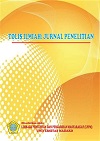THE STUDENTS’ PERCEPTION TOWARD THE IMPLEMENTATION GOOGLE MEET AS E-LEARNING PLATFORM AT THE SECOND-SEMESTER OF MADAKO UNIVERSITY
DOI:
https://doi.org/10.56630/jti.v3i2.168Abstrak
The aimed of this research was to investigate the students’ perception toward the implementation Google meet as e-learning platform at the second-semester of Madako University. The design of this research was a qualitative research. The research samples were consisted of 16 students at B Class of 2th semester, which used purposive sampling. The data obtained from questionnaires and interviews. The technique used to analyze were percentage and Males and huberman. the data were analyzed through some steps among data reduction, data display and conclusion drawing. from the data analysis, the researcher found some conclusion of students’ perception was perceived of usefulness (14%), actual use (19%), perceived ease to use (36%), attitude aspect (6%), behavior intention (12.5%) and computer self-efficacy (50%). in the result of interview included perceived of usefulness, actual use, perceived ease to use, attitude aspect, behavior intention and computer self-efficacy.Key words: Students’ Perceptions, Google Meet, Implementation, LMS
Referensi
Ahmadi, A. (2016). Evaluasi Pelaksanaan E-learning pada Proses Pembelajaran Sistem Kelistrikan Siswa Kelas X Jurusan Teknik Otomotif di SMKN 2 Pengasih. Skripsi, Universitas Negeri Yogyakarta, Yogyakarta.
Al-Busaidi, K. A. (2013). An empirical investigation linking learner’s adoption of blended learning to their intention of full e-learning. Behavior and Information Technology, 32(11), 1168-1176.
Alfandi, H. A., & Mahdi, H. S. (2020). Measuring Students’ Use of Zoom Application in Language Course Based on the Technology Acceptance Model (TAM). Journal of Psycholinguistic Research, 5.
Ary, D., Jacobs, L. C., & Sorensen, C. (2010). Introduction to Research in Education. USA: Wadsworth
Azhari,.F.A.,& Ming, L. C. (2015). Review of e-learning practice at the tertiary education level in malaysia. Indian Journal of Pharmaceutical Education and Research, 49(4), 248-257.
Azwar S. (2013). Sikap Manusia: Teori dan Pengukuranya. Yogyakarta: Pustaka Pelajar.
Bimo, Walgito. (2010). Pengantar Psocologi Umum. Yogyakarta: C.V Andi.
Burnett, C. (2008). Core Concepts of Marketing. Zurich: Global Text Project.
Creswell, John W. (2012). Research Design Pendekatan Kualitatif, Kuantitatif, dan Mixed. Yogyakarta: Pustaka Pelajar.
Daryanto. (2013). Inovasi Pembelajaran Efektive. Bandung: Yrama Widya.
Darwis, A. (2020). IMPROVING SOCIAL SCIENCE LEARNING OUTCOMES BY USING THE LEARNING MODEL THINK PAIR SHARE VIIB CLASS STUDENTS SMP 4 TOLITOLI. Jurnal Madako Education, 6(1).
Davis, F. D. (1989). Perceived usefulness, Perceived ease of use, and user acceptance of information technology. MIS Quarterly, 13(3), 1-9.
Darwis, A., Malik, A. R., Burhan, B., & Marto, H. (2020). Studi Kasus Teman Sebaya Dalam Pembentukan Gaya Hidup Siswa. Kaganga: Jurnal Pendidikan Sejarah dan Riset Sosial-Humaniora, 3(2), 150-160.
Dessta Putra Wijaya. (2015). Implementasi e-learning di smp negeri 10 yogyakarta. Skripsi. UNY.
Gitosudarmo, I. & Sudita, I. N. (2015). Perilaku Keorganisasian. Yogyakarta: BPEE Yogyakarta.
Holden, H., & Rada, R. (2011). Understanding the infuence of perceived usability and technology selfefcacy on teachers’ technology acceptance. Journal of Research on Technology in Education, 43(4), 343–367. https://doi.org/10.1080/15391523.2011.10782576.
Indrawati, I., Marzuki, M., & Malik, A. R. (2021). Investigating the Effect of Reward and Punishment on the Student’s Learning Achievement and Discipline. Linguistic, English Education and Art (LEEA) Journal, 4(2), 337-350.
Liu, ANAM, & Ilyas, I. (2020). The Influence of Online Learning Based on Zoom Cloud Meeting on Learning Outcomes of Physics Students at the University of Flores Journal of Physics and Scientific Education (JPFK) Online Lectures as a Learning Facility During the Covid-19 Quarantine Period. Journal of Business and Management Strategy Studies, 4, 37–45.
Malik, A. R., & Asnur, M. N. A. (2019). USING SOCIAL MEDIA AS A LEARNING MEDIA OF FOREIGN LANGUAGE STUDENTS IN HIGHER EDUCATION. Bahtera: Jurnal Pendidikan Bahasa Dan Sastra, 18(2), 166-75.
Malik, A. R., Emzir, E., & Sumarni, S. (2020). PENGARUH STRATEGI PEMBELAJARAN MOBILE LEARNING DAN GAYA BELAJAR VISUAL TERHADAP PENGUASAAN KOSAKATA BAHASA JERMAN SISWA SMA NEGERI 1 MAROS. Visipena, 11(1), 194-207.
Malik, A. R. (2019, August). THE INFLUENCE OF INSTAGRAM AND AUDITORY LEARNING STYLE ON GERMAN LANGUAGE MASTERY IN STUDENTS OF SMAN 1 MAROS. In International Conference on Cultural Studies (Vol. 2, pp. 279-283).
Marzuki, M., & Malik, A. R. (2021). Kesulitan Guru Bahasa Inggris Dalam Menggunakan E-Learning Selama Pandemi COVID-19. Jurnal KIBASP (Kajian Bahasa, Sastra dan Pengajaran), 4(2), 127-146.
Miles, M. B, Huberman, A, M, and Saldana, J. (2014). Qualitative Dana Analysis Methods Sourcebook, edition 3. USA: Sage Publications. Terjemahan Tjetjep Rohindi, UI-Press.
Moore, J. L., Dickson-Deane, C., & Galyen, K. (2011). E-learning, online learning, and distance learning environment: are they the same? Internet Higher education, 14(2), 192-135.
Jacub, T. A., Marto, H., & Darwis, A. (2020). MODEL PEMBELAJARAN PROBLEM BASED LEARNING DALAM PENINGKATAN HASIL BELAJAR IPS (STUDI PENELITIAN TINDAKAN KELAS DI SMP NEGERI 2 TOLITOLI). Tolis Ilmiah: Jurnal Penelitian, 2(2).
Kurtz & Boone. (2012). Kurtz & Boone, 489.
Lodico, G, Marguerite, Dean T. Spailding, Katherine H. Voegtle. (2006). Methods in Education Research From Theory to Practice San Frasisco. Jossey Bass. Retrieved November 10, 2020, from http://journal.methods.ac.id,
Ming-Chi Lee. (2010). Explaining and predicting users’ continuance intention toward e-learning:an extention of the expectation-confirmation model. Computer & Education 54 (2010) 506-516.
Purwadani, Indah. (2016). Pengembangan Elearning berbasis Claroline untuk Pengembangan PTIK. Prosiding KNIT 2 Vol 2 No 1 2016.
Przybylski, A., Murayama, K., DeHaan, C., & Gladwell, V. (2013). Motivational, emotional, and behavioral correlates offear of missing out. Coputers in Human Behaviour, 1841-1848.
Robbin, S. (2008). Perilaku Organisasi, Jilid 1 dan II, alih bahasa: Hadyana Pujaatmaja. Jakarta: Prenhallindo.
Rusman, (2012). Model-Model Pembelajaran: Mengembangkan Profesionalisme Guru, RajaGrafindo Perseda, Jakarta.
Saugadi, S., Malik, A. R., & Burhan, B. (2021). Analisis Upaya Guru dalam Mengatasi Kesulitan Belajar Membaca Siswa. Jurnal KIBASP (Kajian Bahasa, Sastra dan Pengajaran), 4(2), 118-126.
Sanchez-Priesto, J. C., Olmos-Miguelanez, S., & Garcia-Penalvo, F. J. (2014). Understanding obile learning:Devices, pedagogical implications and research lines. Revista Teoria De La Education: Education Y Cultura En La Sociedad De La Information, 15(1), 20-24.
Scherer, R., Siddiq, F., & Tondeur, J. (2019). The technology acceptance model (TAM): A meta-analytic structural equation modeling approach to explaining teachers’ adoption of digital technology in education. Computers & Education, 128, 13–35. https://doi.org/10.1016/j.compedu.2018.09.009.
Sugiyono, (2009). Metode Penelitian Kuantitatif, Kualitatif dan R&D, Bandung: Alfabeta.
Sugiyono, (2017). Metode Penelitian Kuantitatif, Kualitatif dan R&D, Bandung: Alfabeta.
Sukmadinata, Nana Syaodih. (2007). Metode Penelitian Pendidikan. Bandung: Rosdakarya.
Slameto. (2010). Belajar dan factor-faktor yang Mempengaruhinya. Jakarta: PT. Rineka Cipta
Sheldon, P. (2016). Facebook friend request: Applying the theory of reasoned action to student-teacher relationships on Facebook. Journal of Broadcasting & Electronic Media, 60(2), 269–285. https://doi. org/10.1080/08838151.2016.1164167.
Turner, M., Kitchenham, B., Brereton, P., Charters, S., & Budgen, D. (2010). Does the technology acceptance model predict actual use? A systematic literature review. Information and Software Technology, 52(5), 463–479. https://doi.org/10.1016/j.infsof.2009.11.005.
Thoha Miftah. (2010). Pembinaan Organisasi, proses dianosa dan intervensi, Managemen Kepemimpinan. Yogyakarta, Gava Media.



















